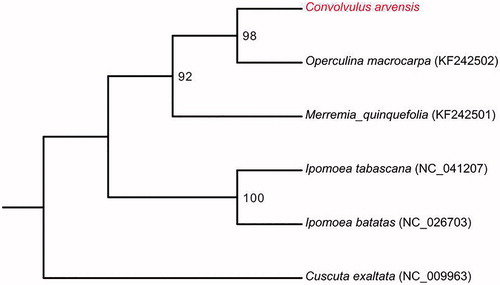Abstract
The complete chloroplast genome of Convolvulus arvensis was reconstructed by reference-based assembly using Illumina paired-end data. The assembled plastome is 153,234 base pairs (bp) in length, including a pair of inverted repeat regions (IRs) of 22,662 bp each, a large single-copy region (LSC) of 89,059 bp and a small single-copy region (SSC) of 19,651 bp. A total of 115 genes were predicted from the chloroplast genome, including 74 protein coding genes, 37 tRNA genes and 4 rRNA genes. The overall GC content of C. arvensis chloroplast genome was 37.7%. Phylogenetic analysis with several reported chloroplast genomes showed that C. arvensis is closely clustered with Operculina macrocarpa. The complete chloroplast genome of C. arvensis provides new insight into the evolutionary and genomic studies of Convolvulaceae.
The perennial herb Convolvulus arvensis is widely distributed in the temperate regions of the world. It is a common stubborn weed in croplands. Meanwhile, it is also widely used as a traditional Chinese medicine. To date, the phylogenetic position of C. arvensis in the Convolvulaceae is still unclear. In this study, we first reported the complete chloroplast (cp) genome of C. arvensis and reconstructed a plastome phylogeny for the Convolvulaceae.
The mature and healthy leaves of a single individual of C. arvensis was sampled from Yinchuan Botanical Garden in Ningxia, NW China (38.42062°N, 106.177704°E). The voucher specimen was deposited in the Herbarium of Sichuan University (accession number: QTPLJQ14382553). The total genomic DNA was extracted from silica gel dried leaves using a modified CTAB method (Doyle and Doyle Citation1987) and sequenced based on the Illumina pair-end technology. The filtered reads were assembled using the program NOVOPlasty (Dierckxsens et al. Citation2017) with complete cp genome of Ipomoea batatas as the reference (GenBank accession no. NC_026703). The assembled cp genome was annotated using Plann (Huang and Cronk Citation2015), and the annotation was corrected using Geneious (Kearse et al. Citation2012). To examine the phylogenetic position of C. arvensis, a multiple sequence alignment (MSA) analyses was performed using MAFFT v7.313 (Katoh and Standley Citation2013) based on six cp genomes in the Convolvulaceae. Finally, a maximum likelihood (ML) tree was constructed by RAxML v8.2.11 (Stamatakis Citation2006) with 500 bootstrap replicates based on the alignments, using Cuscuta exaltata as outgroup.
The complete cp genome of C. arvensis was a circular molecular genome with a size of 153,234 bp in length, which presented a typical quadripartite structure containing two inverted repeat (IR) regions of 22,662 bp separated by the large single-copy (LSC) region of 89,059 bp and small singlecopy (SSC) region of 19,651 bp. The cp genome consists of 115 genes including 74 protein coding genes, 37 tRNA genes, and 4 rRNA genes. The overall GC content was about 37.7%. In the plastome phylogeny, C. arvensis shows the closest genetic relationship to Operculina macrocarpa. (98% bootstrap support) (). The C. arvensis cp genome can be further used for population genomic studies, phylogenetic analyses, genetic engineering studies of Convolvulaceae.
Acknowledgements
The authors thank Dr. Lei Zhang from Sichuan University for the help of plant material collection.
Disclosure statement
None of the coauthors has any conflict of interest to declare. The authors alone are responsible for the content and writing of the paper.
Data availability statement
The data that support the findings of this study are openly available in NCBI GenBank database at https://www.ncbi.nlm.nih.gov/ with the accession number is MW054627 or available in [figshare.com] at https://doi.org/10.6084/m9.figshare.13025090. Raw sequencing reads used in this study have been deposited in the SRA database of NCBI under accession number SRR12936120.
Additional information
Funding
References
- Dierckxsens N, Mardulyn P, Smits G. 2017. NOVOPlasty: de novo assembly of organelle genomes from whole genome data. Nucleic Acids Res. 45(4):e18.
- Doyle JJ, Doyle JL. 1987. A rapid DNA isolation procedure for small quantities of fresh leaf tissue. Phytochem Bull. 19:11–15.
- Huang DI, Cronk Q. 2015. Plann: a command-line application for annotating plastome sequences. Appl Plant Sci. 3(8):1500026.
- Katoh K, Standley DM. 2013. MAFFT multiple sequence alignment software version 7: improvements in performance and usability. Mol Biol Evol. 30(4):772–780.
- Kearse M, Moir R, Wilson A, Stones-Havas S, Cheung M, Sturrock S, Buxton S, Cooper A, Markowitz S, Duran C, et al. 2012. Geneious Basic: an integrated and extendable desktop software platform for the organization and analysis of sequence data. Bioinformatics. 28(12):1647–1649.
- Stamatakis A. 2006. RAxML-VI-HPC: maximum likelihood-based phylogenetic analyses with thousands of taxa and mixed models. Bioinformatics. 22(21):2688–2690.

